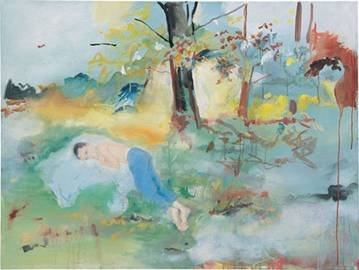Jochen Klein
dal 5/3/2008 al 7/6/2008
Segnalato da
5/3/2008
Jochen Klein
Pinakothek der Moderne, Munich
The immediate reason and focus of the show is provided by eight central paintings that the artist and partner of Jochen Klein, Wolfgang Tillmans, is donating to the Pinakothek der Moderne. In his pictorial reality experienced reality blends with utopian desires, political sensitivity mediates with personal self-assertion. Curated by Bernhart Schwenk.

curated by Bernhart Schwenk in collaboration with Wolfgang Tillmans
The exhibition is dedicated to the final work period of the artist Jochen
Klein, who died young (1967 – 1997). The immediate reason and focus of the
show is provided by eight central paintings that the artist and partner of
Jochen Klein, Wolfgang Tillmans, is donating to the Pinakothek der Moderne.
Along with works on loan from private collections these pictures sketch the
high point of an unmistakable oeuvre and at the same time mark a general
turning point in painting of the 1990s – the repositioning of figurative
painting with the experience of Concept Art. Along with Jochen Klein other
fellow artists, some of them friends, pursued similar paths of conceptual
figurative painting, among them Peter Doig, Thomas Eggerer, Silke Otto
Knapp, Elizabeth Peyton, Amelie von Wulffen.
He started out with classical art studies under Hans Baschang at the Academy
of Fine Arts in Munich. After qualifying, however, Jochen Klein initially
abandoned painting and turned instead to conceptual projects. Influenced by
the then widespread unease towards the medium of painting Klein joined
Thomas Eggerer in becoming a member of Group Material, a Concept Art group
based in New York. In this connection he worked with them on a number of
different exhibitions largely focused on social history until the group was
dissolved. He also wrote numerous essays on the relationship between
aesthetics and politics.
After this eminently important period of abstinence from painting Jochen
Klein took up this artistic medium again following his relocation to London
in 1996. Right up to his sudden death in 1997 he worked with great energy on
a painting, in which virtuoso colourism blends with the scepticism and
experience of his conceptual projects.
Among the earliest pieces of the later work period are collaged pictures
portraying geese, puppies and guinea pigs playing together in the grass.
There is no further reference – at first glance a suspiciously harmless
world, one that is the greatest imaginable contrast to the cool
installations of Conceptual Art. Aesthetic experience of everyday life
served Jochen Klein as source of inspiration: photo wallpapers, magazine
advertisements, drugstore calendars, erotic films from the 1970s. He
recognised in these motifs the vocabulary of a collective consciousness in
whose cliché-like nature cryptic messages for individual desires are
mirrored. Paradoxically there is a sense of intimacy in this very distance,
underlining the artist’s interest and ability to see what is used in a new
light.
The best known pictures of this most important and final period of Jochen
Klein’s life show idyllic scenes in rural settings: meadows of flowers,
forest glades, trunks of birch trees, autumn leaves. Figures appear here and
there, partly collaged, partly painted – but practically always in contrast
to an almost stylised background. The motivic quality of the pictures
reminds one of those idyllic shepherd scenes and construed landscapes that
were so popular in18th century painting. It is only on closer investigation
that the ambivalence of these scenarios comes to light.
In Jochen Klein’s pictorial reality experienced reality blends with utopian
desires, political sensitivity mediates with personal self-assertion.
Traditional, sometimes cliché-like and kitsch forms of representing nature,
feminity and childhood are transformed into pictorial compositions of great
sophistication with many meanings. They impart a sense of ‚joie de vivre’,
but also a marked awareness of a vulnerable and transient physicality.
Wolfgang Tillmans’ generous donation of eight significant paintings by
Jochen Klein to the Pinakothek der Moderne is a great enrichment – and that
in more ways than one: on the one hand, Jochen Klein’s paintings continue an
important focus of the Sammlung Moderne Kunst, namely figurative painting of
the 20th century ranging from Kirchner, Dix and Bacon to Rauch and Doig. On
the other, the works complement with their numerous references the „Munich
Installation“ of Wolfgang Tillmans, which was acquired for the museum three
years ago thanks to PIN., Friends of the Pinakothek der Moderne. And
finally, Jochen Klein represents an important link to the succeeding
generation of young artists.
Opening: 06.03.2008, 19
Pinakothek der Moderne
Barer Strasse 40 - Munich



